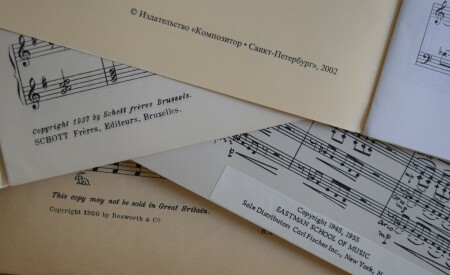Tools for dealing with copyrights and usage restrictions on cultural content
Online access to digital cultural content and the ability to re-use this content for free are too often impeded by usage restrictions and a lack of good rights metadata. We want this project to provide cultural organisations with tools that help them deal with rights and usage restrictions on cultural content, for example by identifying these restrictions correctly and enabling online access and re-use.

© Bib Conservatorium Brussel, School of Arts Erasmushogeschool
Questions about copyrights and usage restrictions
We regularly receive requests for information about rights on cultural content: what metadata needs to be documented? How do you indicate the rights status of cultural content on the internet? How do you carry out research into rights for large quantities of orphan content? The often complex, layered rights status of content that we digitise and unlock in collaboration with content partners even presents us with challenges in our own work. For example, in order to make images available via artinflanders.be, we need to inform users about the rights status both for the original content and its digital copy. We’re aiming to use template documents and practices to help ourselves take a step forward, and provide organisations working in various domains in the cultural sector with tools to do the same.
Objectives
This project has the three following short-term objectives:
Develop specific and user-friendly tools and practices to make orphan and out-of-commerce works accessible;
Formulate specific implementation requirements for rights management in digital asset management (DAM) systems;
Set up reference examples to provide end users with transparent information about the rights status of cultural content.
We want to achieve the following long-term objectives with this project:
Encourage cultural organisations to tackle gaps in their rights management by offering good practices for researching and documenting rights status;
Lower the threshold for cultural organisations to make orphan and out-of-commerce content accessible by developing good practices for rolling out open content policies and thoroughly researching the rights status;
Find a good balance between making images of heritage objects freely available and respecting the makers’ (intellectual ownership) rights and business models, by developing template documents for transferring and revoking rights;
Encourage image database providers to offer a tool for cultural organisations to adequately document content rights and rights holders ‘by default’, by providing a shared data model for documenting rights and usage restrictions.
Our approach
This project consists of three main sections: developing a shared data model, a series of pilot projects, and delivering tools and good practices.
The shared data model must make it possible to document rights statements, rights holders and usage restrictions. Following a literature study into standard data structures for documenting rights, specifications are drawn up for a cross-domain data model. Existing rights statements at rightsstatements.org are translated into Dutch.
We’re supervising six pilot projects in which tools and good practices are developed and tested against cultural organisations’ current practices. Each project consists of:
establishing a work plan;
developing tools;
one or more test iterations;
reporting.
The tools and good practices that we develop are for:
performing risk analyses for orphan and out-of-commerce content;
developing an open content policy tailored to the cultural organisation and creator in question;
documenting metadata about rights and usage restrictions;
thoroughly researching the rights status of content.
Partners
We’re setting this project up in collaboration with the cultural heritage bodies Kusterfgoed and COMEET, the Library of the Royal Conservatory Brussels, STAN theatre collective, M Leuven and Letterenhuis. These organisations represent various sub-sectors of the wider cultural field, and are impeded in their work by a lack of rights metadata. We will run a pilot project with each of them. Joris Deene/Everest Law and Cultuurloket will be providing us with legal expertise. Histories vzw are supporting us their expertise about working with volunteers. This project is funded by a grant from the Flemish Government for cultural heritage projects.
The Public Domain Tool
What if we could partly automate the workload created by a lack of rights metadata and the fact that rights statuses change over time? More and more data is being aggregated on Wikidata all the time, which creates an opportunity to respond to this need. Parallel to this project, in 2020 we drew up tender documentation for the Flemish government to develop a Public Domain Tool that will enable users:
to determine with certainty which works are in the public domain;
to determine when the copyright protection expires for works that are definitely not currently in the public domain.
This is done on the basis of:
the date the work was created;
the name(s) of the author(s) and possibly their year of death;
data from collection managers and Wikidata.
We’re expecting to deliver the tool at the end October 2020. Is your cultural heritage management organisation interested in testing it? Then please contact our colleague, Bart Magnus.
- T • +32 9 298 05 01
- M • bart.magnus@meemoo.be
